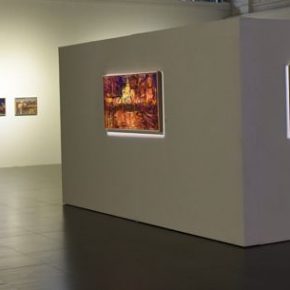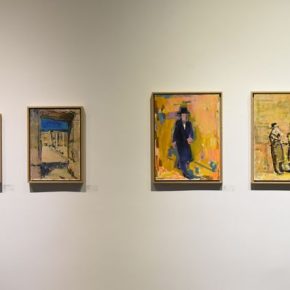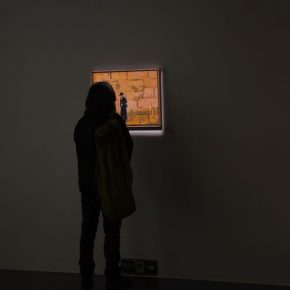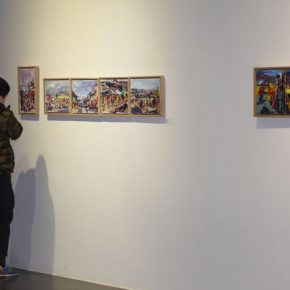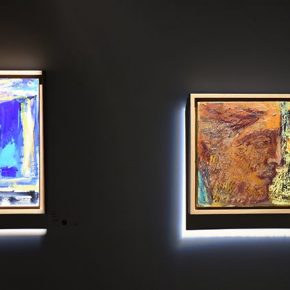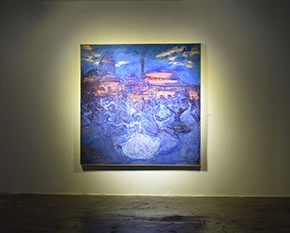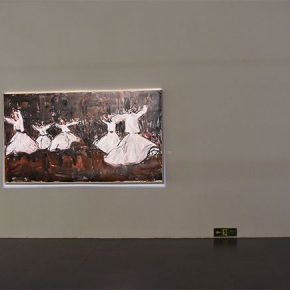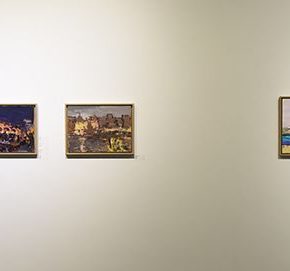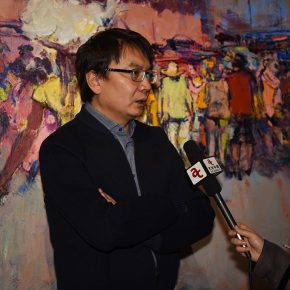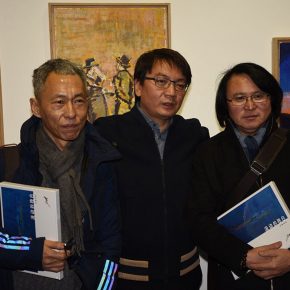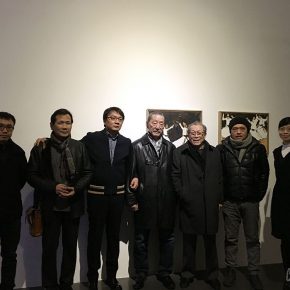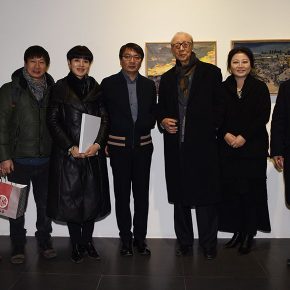
At 3:00 pm on December 23, 2017, Shi Yu’s latest solo exhibition of “Flowing Monologues” was opened at Bridge Art Space in 798 Art District. The honored guests attending the opening ceremony of the exhibition included Prof. Wang Shaojun, Deputy Party Secretary of CAFA, Sun Hongpei, Deputy Party Secretary of Beijing Normal University, and Shi Yu’s teachers including Professors Zhong Han, Zhan Jianjun, Yuan Yunsheng, Dai Shihe and Li Yanzhou from the Department of Oil Painting, CAFA, as well as the famous artists, the couple, Liu Xiaodong and Yu Hong, Zhang Yanzi, Executive Editor-in-Chief of CAFA ART INFO, as well as Shi Yu’s peers and artists Ma Xiaoteng, Liu Shangying, Bai Xiaogang, Yuan Yuan, Liu Xiaohui and many more.
Prof. Li Jun, Deputy Dean of the School of Humanities, CAFA, serves as the academic chair of the exhibition and Tang Yu served as the curator. The exhibition shows a total of more than 30 pieces created by Shi Yu when he traveled to different cultural regions of the world over the last year. Crossing from the South Asian subcontinent, the Middle East and the Mediterranean coast to the North and Central America, different ethnic groups, different beliefs and different groups of people brought Shi Yu strange and various fresh feelings, different regions have different customs, language and skin color, and Shi Yu was so close to the local people or things that they had a resonance in breathing and expressing the local cultural and psychological state on the screen.
Prof. Li Jun wrote a preface that read: “Year after year, one spring after one spring, crossing a dome after a dome, Shi Yu has been walking in the dome of the blue sky. Stones are weeping, midnight is brilliant, it is silent but for thunderstorms, everything is noisy and lonely. When Shi Yu painted, he could hear it and see it. Hemingway said: ‘If you are lucky enough to have lived in Paris as a young man, then wherever you go for the rest of your life it stays with you, for Paris is a moveable feast.’ It is not Paris, but it is more moveable and more sacred than Paris, traveling thousands of miles to the end of the world is actually a journey of entering the inner world.”
Through a rhythmic arrangement of space and light, a flowing, yet quiet exhibition hall has been created. A group of “Ganges” series is arranged surrounding the center of the exhibition hall, with the same Ganges that is still and noisy, of intense color contrast, the constantly moving pilgrims, the reflections within the altar lights, as well as religious sanctity and secular earthy atmosphere, are smoothly presented on the screen with changing light and shade. It is the place where life begins, and ends, regardless of whether it is noble or inferior, the life and death of all things in the world happens in the same place. The passionate sacrifices of PUJA reveal a power of faith that is beyond life in the paintings by Shi Yu.
Located at the other end of Asia, Turkey is the end of the Asian part of the Silk Road, where Islamic and Christian civilizations communicate and penetrate. Turkish dance is the religious dance of the Islamist Mysticism founded by Mevlana who considered all things as a rotation. From birth to death, people are located in a cycle, a kind of rotation. It is through the rotation, a form of dance that we are able to connect and communicate the Universe and God. The work of “Konya”, which is on display at the entrance to the exhibition hall, uses a silhouette, omitting the portrayal of details and the environment but through a strong color relationship, to set off a solemn ritual feeling and theatrical effect.
With the geographical displacement, history is reproduced, like presenting fresh historical images. Shi Yu’s path reveals a love and respect for ancient civilization and old things. In the process of globalization that is marching into the modern civilization, the remains of unique civilizations are undoubtedly the proverbs reflecting the present. At the exhibition hall, “Milos – Night in Bologna”, “Jerusalem in the Sunset”, “Capernaum on the Shore of Lake Galilee” and “Eurasia Land Bridge in Istanbul” are all fragmental feelings of the artist who faced the real scenes. In the face of cold abandonment, destroyed civilizations, frustration and poverty, and the past brilliances, Shi Yu gradually turned from outward flow to introspection and connected these scenes with paintings – the echoes of the barren and lonely are interwoven with Shi Yu’s “soreness”, which is a hint of the screams of desire and the accumulated energy with changing visual colors.
Curator Tang Yu believes that Shi Yu’s paintings are like the text of Orhan Pamuk, that is not only sad at the passing of civilization, but also draws strength from the deep expression of the relics and the flowing carols of the holy days. On the one side, it connects the constant spiritual world of humans, on the other side, the use of warm brushstrokes are used to resist progress and scientific & technological life, he may not temporarily change anything, but one can find the warmth of the memory of civilization from his paintings, in order to nurture their own spiritual picture, which is the flowing monologue of Shi Yu.
Photo and text courtesy of the organizer, translated by Chen Peihua and edited by Sue/CAFA ART INFO.


